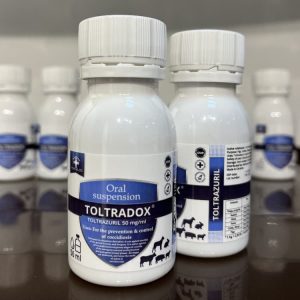Giardia is a common and troublesome protozoal parasite that can affect dogs of all ages, leading to gastrointestinal issues and discomfort. The infection is caused by the microscopic organism Giardia duodenalis (also known as Giardia lamblia or Giardia intestinalis), which resides in the small intestines of infected animals. While Giardia infection, known as giardiasis, is treatable, it can be stubborn and challenging to eliminate entirely. One effective and increasingly popular treatment option for giardiasis in dogs is Toltrazuril, a potent antiprotozoal medication.
Understanding Giardiasis in Dogs
Giardiasis is a gastrointestinal infection that can manifest with a range of symptoms, including diarrhea, vomiting, weight loss, and lethargy. The Giardia parasite has a unique life cycle, involving two forms: the active trophozoites, which attach to the lining of the intestines, and the hardy cysts, which are shed in the feces and can survive in the environment for extended periods. Dogs typically become infected by ingesting the cysts from contaminated water, food, or surfaces.
Giardiasis can be challenging to diagnose as the parasite may not be consistently present in the feces. Multiple fecal samples may be required to detect the cysts or trophozoites accurately. Additionally, some infected dogs may show no symptoms, making the spread of the parasite particularly concerning in multi-dog households or kennels.
Conventional Treatments for Giardiasis
In the past, the standard treatment for giardiasis in dogs involved medications such as metronidazole or fenbendazole. While these drugs can be effective in some cases, giardia has shown a propensity to develop resistance to these treatments over time. Moreover, some dogs may experience adverse reactions to these medications, further complicating the treatment process.
The Rise of Toltrazuril as an Effective Treatment
Toltrazuril has emerged as a promising alternative for giardiasis treatment in dogs due to its potent antiprotozoal properties and favorable safety profile. Initially developed to combat coccidiosis in livestock, Toltrazuril has shown effectiveness against other protozoal parasites, including Giardia, in various animal species.
How Toltrazuril Works Against Giardia
Toltrazuril belongs to the triazine family of drugs and acts by disrupting the metabolic processes of the parasite, inhibiting its development and reproduction. The medication targets both the trophozoite and cyst forms of Giardia, making it an effective choice for eradicating the parasite from the dog’s gastrointestinal tract and reducing the risk of reinfection.
Toltrazuril’s Advantages Over Conventional Treatments
One of the main advantages of using Toltrazuril for giardiasis is its reduced likelihood of inducing resistance in the parasite. Unlike some conventional treatments, Toltrazuril has not shown a significant risk of resistance development, making it an appealing option for recurrent or treatment-resistant cases of giardiasis.
Additionally, Toltrazuril is generally well-tolerated by dogs, with a lower incidence of adverse effects compared to other medications. This is particularly beneficial for dogs with sensitivities or intolerances to other antiprotozoal drugs.
Administering Toltrazuril to Dogs
Toltrazuril is available in various formulations, including oral suspensions, powders, and tablets. The specific dosage and treatment duration depend on the dog’s weight, the severity of the infection, and the veterinarian’s assessment. It is essential to follow the veterinarian’s instructions carefully to ensure the optimal treatment outcome.
Preventing Giardia Infections
Prevention is key to managing giardia in dogs. Regularly disinfecting living areas, providing clean drinking water, and avoiding exposure to contaminated environments can reduce the risk of infection. Additionally, practicing good hygiene, especially in multi-dog households or kennels, can help prevent the spread of giardia.
In conclusion, giardiasis can be a challenging condition to treat in dogs, but Toltrazuril has emerged as a promising and effective option for combating this stubborn parasite. Its potency against Giardia, coupled with its favorable safety profile, makes it a valuable tool in the battle against giardiasis and a welcomed alternative to conventional treatments. If your dog is showing signs of giardiasis, consult with a veterinarian to determine the most appropriate treatment plan, and consider Toltrazuril as a potential solution for a faster and more successful recovery.
Reducing Risk of Reinfection
Furthermore, using Toltrazuril as a treatment for giardiasis in dogs may help reduce the risk of reinfection and the need for repeated treatments. Unlike some conventional medications that may require multiple rounds of administration, Toltrazuril’s effectiveness in targeting both trophozoites and cysts in the Giardia life cycle means a more comprehensive and thorough eradication of the parasite.
It is important to note that while Toltrazuril has shown promising results in treating giardiasis, individual responses may vary. Some dogs may experience rapid improvement after treatment, while others may require additional time for a complete recovery. As with any medication, close monitoring by a veterinarian is crucial to assess the dog’s progress and adjust the treatment plan as needed.
Consulting Veterinarian
Before administering Toltrazuril or any other medication, it is essential to consult with a veterinarian for an accurate diagnosis of giardiasis. A thorough examination and appropriate diagnostic tests, such as fecal analysis, will confirm the presence of Giardia and help the veterinarian determine the most suitable treatment approach.
In addition to medical treatment, maintaining good hygiene practices is vital in preventing the spread of giardiasis and protecting other pets and humans from infection. Regularly cleaning and disinfecting your dog’s living area, promptly removing feces from the environment, and providing clean drinking water are essential preventive measures.
Remember that giardiasis is not just a concern for dogs; it can also be transmitted to humans, particularly young children and individuals with compromised immune systems. Therefore, it is essential to practice good hygiene and sanitation not only for your dog’s well-being but also for the health of your entire family.
Incorporating Toltrazuril as part of a comprehensive treatment plan for giardiasis in dogs not only addresses the current infection but also helps to break the transmission cycle of the parasite. By effectively eliminating both the active and dormant forms of Giardia, there is a reduced risk of shedding infectious cysts into the environment, protecting other dogs and animals from potential exposure.
Additionally, Toltrazuril’s ease of administration contributes to its popularity as a treatment choice for giardiasis. Various formulations, such as oral suspensions or tablets, offer flexibility in dosing, making it convenient for both pet owners and veterinarians.
Stick to the Dosage Requirements
As with any medication, it is crucial to adhere strictly to the prescribed dosage and treatment duration. Abruptly discontinuing the treatment or deviating from the recommended dosage may result in incomplete eradication of the parasite, leading to persistent or recurrent infections.
While Toltrazuril is generally considered safe for dogs, there may be instances of mild side effects, such as transient gastrointestinal upset. If you observe any unusual reactions in your dog during or after treatment, promptly inform your veterinarian.
In some cases, veterinarians may recommend a follow-up fecal examination after the completion of the treatment to ensure the complete eradication of Giardia. This allows them to assess the treatment’s efficacy and make any necessary adjustments if there are still traces of the parasite present.
While Toltrazuril is an effective option for treating giardiasis, prevention remains the most robust defense against this parasitic infection. Avoiding the ingestion of contaminated water and food, especially in outdoor settings, can significantly reduce the risk of your dog contracting Giardia. Additionally, if your dog is known to have Giardia or has been in contact with infected animals, taking precautions to prevent the spread of the parasite to other dogs or humans is essential.
Conclusion
In conclusion, Toltrazuril has established itself as a powerful weapon in combating giardiasis in dogs. Its ability to target both active and dormant forms of the parasite, along with its low risk of resistance development, makes it a preferred treatment choice for veterinarians. However, responsible pet ownership, good hygiene practices, and early detection and treatment of giardiasis are equally critical in managing and preventing the spread of this common and persistent parasite.
If you suspect your dog may have giardiasis or is exhibiting symptoms of gastrointestinal distress, seek prompt veterinary attention. A veterinarian can provide an accurate diagnosis and recommend the most appropriate treatment plan, which may include the use of Toltrazuril to help your furry friend overcome the challenges of giardia infection and enjoy a healthier, happier life.





